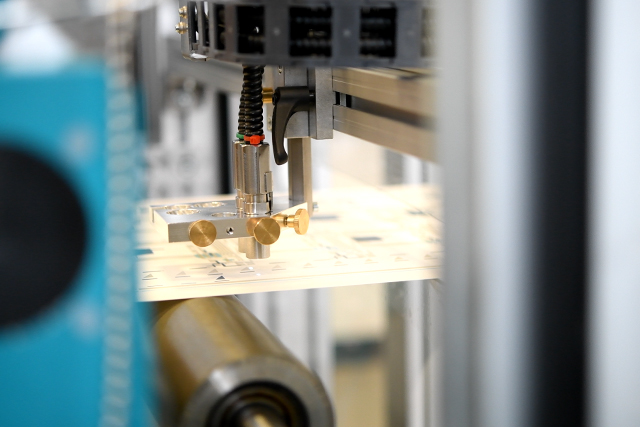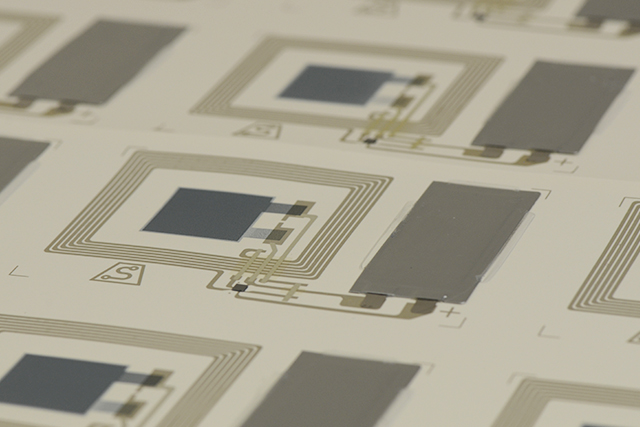SUPERSMART – paper-based printed electronics as environmentally friendly and cost-efficient alternative
The SUPERSMART research project funded by EIT RawMaterials has shown proof: printed electronic components such as sensors and smart labels on paper can play an essential role in building a smart environment for production, retail and logistics. Efficient and reliable production processes make them economically competitive. In terms of resource conservation, climate and the environment, electronics printed on paper have outstanding advantages over conventional substrates and manufacturing processes for smart electronic components. The SUPERSMART project team is proud to have been selected by the international jury as the winner of the 2021 OE-A competition within the category "Best Publicly Funded Project Demonstrator". The award ceremony will take place on April 15, 2021.
Why paper?
The packaging market in Europe, as well as the electronics industry, is on the move. Miniaturized and cost-efficient electronic labels are able to monitor transport and logistics or provide forgery-resistant information about the origin and authenticity of products. Intelligent packaging creates added value; however, at the same time, plastic packaging in particular is facing a radical change. Society's obligation to protect the climate and conserve resources has led to stricter guidelines and laws on the components that are still permitted (REACH, RoHS etc.). This also led to the EU Packaging Regulation to control the use of plastic packaging. Therefore, the search for more environmentally friendly and cost-efficient alternatives is becoming increasingly important for the economy.
This is where the old material paper is shining again. Made from renewable raw materials, it is durable and the recycling is well established, and in the end, even biodegradable if processed appropriately. Up to now, paper has hardly played a role as carrier material for electronic devices, because paper cannot be combined with classic electronic manufacturing. In SUPERSMART, a European consortium with eleven partners has spent three years on bringing printed electronics to paper using highly scalable technological processes that also allow mass production.
In SUPERSMART, materials and processes were matched for two application examples - a shock detection sensor and an intelligent anti-counterfeit label - to print electronic circuits and displays directly on paper. Both components can simply be read out via a cell phone app.
Availability of functional materials
One big challenge on the way to smart labels on paper was the availability of printable, functional, and affordable materials with reliable and constantly high quality without batch-to-batch variations. SUPERSMART project put particularly attention on the scale-up and quality control of materials in order to support all companies that want to proceed with functional tags and smart labels. Next to functional paper, SUPERSMART put its focus and development for example on piezopolymers, ferroelectric nanoparticles, electrochromic materials, metal-oxide semiconductors and barrier coatings for papers.
In order to demonstrate that the up-scaled materials have the same quality for high-through-put techniques – compared to labels and materials processed in the lab – roll-to-roll and sheet-to-sheet processes were established. Even, the poling of piezoelectric material was scaled up by an automated poling station. Pick-and-place technologies were applied on functional paper in order to integrate conventional microelectronic components (batteries, communication chips) if necessary.
Outstanding benefits for climate and environment
A life cycle assessment (LCA) was carried out to determine exactly how resource-efficient printed electronics on paper are and where potential for improvement is needed. Replacing organic or inorganic substrates with paper in manufacturing simplifies subsequent recycling and reduces waste both during processing and at the end of the product's life. Printing processes consume less energy and resources than conventional semiconductor processes. The design for recycling is simplified as well. A direct comparison between paper and PET substrates for the production of electronic devices showed clear advantages of paper. In almost all of the 18 categories examined in the LCA (e.g., global warming, water use or eutrophication, stratospheric ozone depletion, or ecotoxicity) the use of a paper substrate would cause only 10-20% of the impact of PET.
Technological breakthrough for paper-based electronics
With its approach to transferring technologically mature high-throughput processes to the printing of electronic components, the SUPERSMART project has removed major hurdles to wider use. Additionally,the paper-based sensors and labels are attractive for numerous applications. They can easily be integrated into packaging and consumer goods. An anti-counterfeit tag for particularly vulnerable or expensive goods can help to protect manufacturers and consumers from fraud. Large-area shock detection sensors integrated into packaging or other paper-based elements provides transportation protection and event traceability. Finally, these printed elements can be used as security features, that add reliable and cost-efficient smartness to simple products. The smarter the packaging, the greater is the benefit. Even completely new areas of application are conceivable, e.g. filter technology or in the education sector.
Facts about the SUPERSMART project
SUPERSMART-Project
Enabling the direct printing on paper of sensors, displays, and electronics: Easy to design, easy to produce, easy to use, and easy to recycle.
Partners
- Arkema, France (Projekt Koordination)
- Arjowiggins France S.A.S, Frankreich
- Centre National de la Recherche Scientifique-2 (CNRS-UB), Frankreich
- Coatema Coating Machinery GmbH, Deutschland
- French Alternative Energies and Atomic Energy Commission (CEA), Frankreich
- Fraunhofer-Institut für Silicatforschung ISC, Deutschland
- Fraunhofer-Institut für Verfahrenstechnik und Verpackung IVV, Deutschland
- Joanneum Research, Österreich
- Luquet & Duranton, Frankreich
- VTT Technical Research Centre of Finland Ltd. (VTT), Finnland
- NOVA School of Science and Technology | FCT NOVA, Universidade NOVA de Lisboa, Portugal
- Université de Bordeaux, Frankreich
Website


Last modified:

